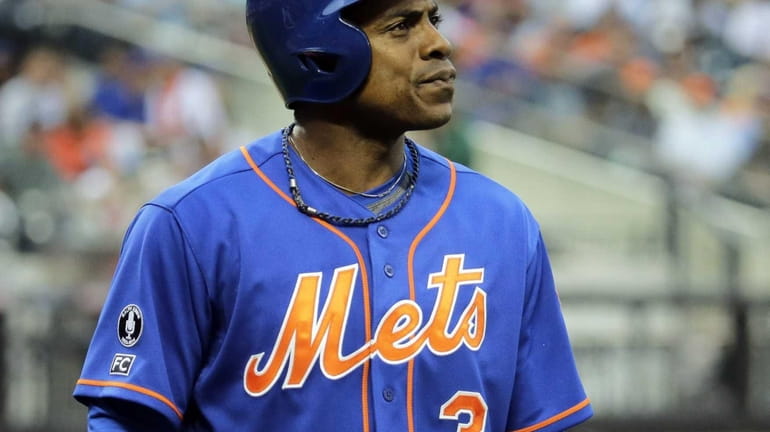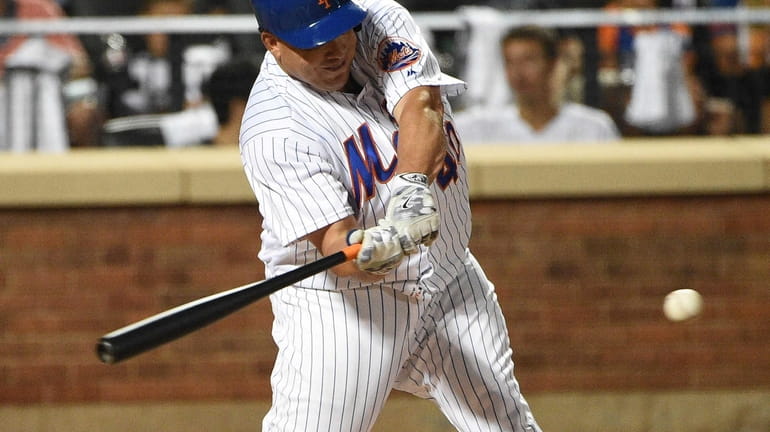Curtis Granderson getting a whiff of Yankees, Mets record books

Mets rightfielder Curtis Granderson reacts as he walks back to the dugout after fouling out to San Francisco Giants third baseman Pablo Sandoval in the first inning at Citi Field on Aug. 1, 2014. Credit: Ray Stubblebine
Of the 125 players who have spent time with both the Mets and Yankees, no one has swung and missed quite as often as Curtis Granderson.
As Granderson's disappointing first season with the Mets nears its end, the slumping outfielder has an outside chance to make some unwanted New York baseball history.
Already the owner of the Yankees' single-season strikeout record, Granderson has a chance to do the same with the team that plays across town.
Granderson needs to strike out 34 more times in the Mets' final 20 games to eclipse the club record of 161 set by David Wright in 2010.
Granderson set the Yankees' record in 2012 with 195. He broke his own club record of 169 set the previous season.
Although strikeouts have become more prevalent in the game -- and perhaps more acceptable, too -- clearly no player would want his name in any club's record book for such an honor, let alone two teams.
How much is this on Granderson's mind these days?
"Not at all," he said.
That the two teams happen to be the Mets and Yankees is a bizarre twist. It's not common for a player to be a regular for both teams in the prime of his career, partly because the teams are reluctant to make trades with each other.
Granderson, of course, left the Yankees last offseason to sign with the Mets as a free agent. He has appeared in 513 games with the Yankees and 135 with the Mets.
Only four players have played more than 162 games with both teams: Elliott Maddox, Charley Smith, Darryl Strawberry and Robin Ventura. And none of them was as dominant with both teams in any statistical category as Granderson has been.
Of course, that Granderson's "dominant" statistical category is strikeouts is not something he or the Mets will be boasting about in their year-in-review materials.
Granderson has always racked up strikeouts. He whiffed 174 times in 2006, his first full season, setting the tone for what has been a constant in this category.
He said the high strikeout totals don't bother him.
"I look at it as just an out in general," Granderson said. "People say, 'Put it in play because it gives you a chance,' and it does, but there's also some really athletically gifted defenders, including the pitchers. So if you make an out, it's an out."
Granderson acknowledged that outs that advance runners or drive in runs are better than strikeouts, "but that's really the only two situations when an out is better. So for me, it's always been an out, and I'm going to be equally disappointed that I didn't get a hit."
Granderson's teams have come to terms with his strikeout totals, choosing to view it as the cost of doing business with him. That's because with the whiffs came power numbers, at least before this year.
From 2006-13, Granderson struck out every 3.8 at-bats but also homered every 20.3 at-bats. This year, his strikeouts are on par with his career average -- one every 3.9 at-bats -- but his home runs are down, one every 29.1 at-bats. He has 17 in 495 at-bats.
But Granderson said he doesn't view home runs -- or even extra-base hits -- as making up for his strikeouts. He views a player's value in terms of RBIs and runs scored.
"If you do those things, then those are going to be the things that are most looked at of any stat in baseball, besides your team's wins and losses," he said. "Not strikeouts. Not groundouts. Not flyouts. Not errors. Not any of that other stuff.
"If you touch home plate or you do something to allow a player to touch home plate, for me, those are the two most important things.''
No one needs to tell Granderson that he's on pace for career lows in a full season in those two categories, too.

